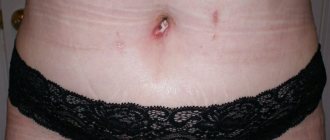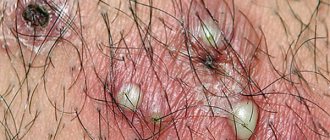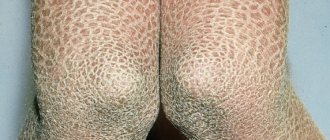What are the possible causes of itching in the neck area? What diseases can cause the neck to itch and turn red on the front, sides and under the chin? What to do if the skin on your neck itches, irritation, redness and rash appear.
Itchy neck is a common dermatological pathology. Typically, the neck itches both in patients with general diseases and in patients with dermatoses. Unpleasant sensations affect the patient’s psychological state, disrupt sleep and reduce quality of life. If the itching on the neck is severe, then you should visit a dermatologist to determine its cause. He will collect a complete history, conduct the necessary studies and only then determine treatment.
Causes
Itching is a normal reaction to an irritant and signals that attention should be paid to a specific area of the skin. Itching can have both physiological and pathological (caused by disease) causes.
Normally, itching and irritation occur due to exposure to damaging factors:
- rubbing with rough seams or accessories;
- bites of blood-sucking insects;
- microdamages when shaving;
- influence of natural factors.
Minor sunburn causes itching and redness. Mostly people involved in agriculture are exposed to such troubles. Severe sunburns can occur with intoxication, severe redness, and the formation of blisters filled with liquid.
Insect bites are also characterized by skin itching and redness. The skin at the site of the bite hurts and swells. A single bite without signs of allergy is not dangerous. But if there are many bites and difficulty breathing occurs, you should urgently seek medical help. Swelling of the larynx and other dangerous allergic reactions are possible.
Mechanical impacts such as frequent shaving, wearing massive metal jewelry, and rough collars on clothes can lead to irritation and itching in the neck area. But if things can be replaced, then it is impossible to completely abandon shaving. To avoid irritation of the facial skin, you should use only a new disposable razor, and also use softening shaving creams and regenerating serums.
What are the reasons for the front of the neck itching?
Dermatologists often encounter itching in the neck area. When your neck itches, the causes of itching in the front are usually different from the causes of itching in the back - it could be a violation of hygiene or a symptom of a serious pathology. Itching causes insomnia, neuroses, and reduces the quality of life. If you experience a strong feeling of discomfort, you should visit a dermatologist. Using screening tests, he accurately diagnoses the disease and prescribes treatment.
Physiological itching is caused by external irritants: changes in temperature, friction of clothing and jewelry, movement of insects.
Pathological reasons for the itching of the front of the neck are skin diseases or improper functioning of internal organs.
Allergic reactions
Often, wearing metal accessories can cause neck itching, especially in the summer. If you are allergic to certain metals, then you should completely abandon such jewelry or replace them with products made from other materials.
Sometimes irritation occurs due to the fact that the skin under the accessory sweats a lot. To avoid this phenomenon, you must follow these recommendations:
- wear jewelry for no more than 4–6 hours;
- do not wear them in the summer heat;
- wash or clean products once a week;
- shower regularly.
Often the cause of itching in the neck area is an allergy to cosmetics and hygiene products. In case of hypersensitivity, it is recommended to use phosphate-free baby powder or gel. All chemicals (deodorants, lotions, eau de toilette) can cause an allergic rash on the neck.
To find out why the rash may occur, you should reconstruct the course of events and understand what product purchased the day before could have caused such a phenomenon. If you cannot find out what caused the allergy, you need to visit a doctor and have allergy tests done.
If you know that your neck itches due to an allergic reaction, then you should avoid contact with the irritant and take an antihistamine (Tavegil, Suprastin).
Allergic manifestations in the neck area
When the neck itches and there is redness, this can indicate both an allergy and manifestations of a dermatological disease. Both are extremely unpleasant. These symptoms have a serious impact on the psyche and emotional state.
With severe itching, sleep disturbance occurs, the person becomes irritable and joyless. To avoid rashes in the neck area, you need to know the cause of their origin.
In this article we will look at why a rash appears and what to do when it appears.
What can cause itching?
The most common factors influencing the formation of itching in the neck area are:
- allergy;
- infection;
- scabies;
- mycosis.
Allergic manifestations on the neck in an adult
Most often, itching and redness of the skin in men indicate an infection, the presence of parasites in the skin or allergies. In the fair half of humanity, these symptoms may appear due to hormonal imbalance.
Non-communicable diseases
Itching on the neck can cause:
- contact dermatitis;
- lichen planus;
- folliculitis;
- prurigo (prurigo).
Excessively dry skin can also cause discomfort. Prolonged exposure to the sun or strong wind provokes the formation of redness, which can itch.
Fungi
One of the reasons why the neck turns red and itches is fungal infections. They manifest themselves as small merging spots, itching and peeling. These diseases are caused by yeast-like fungi. At first the spots are yellow, but over time they become dark red. This pathology is called pityriasis versicolor.
Ringworm can also cause a rash on the neck that itches. Its causative agents are microsporum and trichophyton fungi. The disease most often affects the scalp. The advanced form of the disease can spread to the face, neck and chest. In these areas, round spots with a clear red outline appear.
Psoriasis
This disease is chronic. It manifests itself as inflamed areas and peeling. Psoriasis differs from other pathologies in teardrop-shaped or oval spots, which have a light grayish surface. These plaques protrude on the surface of the skin and are very itchy. The spots are localized on the shoulders, back and neck. Psoriasis is difficult to treat. Therapy takes from six months to two years.
Thyroid pathologies
When the thyroid gland malfunctions, active production of hormones begins: thyroxine and triiodothyronine. This disorder is called hyperthyroidism. With this disease, a person’s weight increases, metabolic disorders occur, and mood swings are observed.
In severe cases of the disease, problems with the heart and reproductive system may occur. With hyperthyroidism, there is itching in the anterior neck, tachycardia, bulging eyes, enlarged goiter, and increased body temperature.
If itching accompanies at least one of the symptoms, you should urgently consult an endocrinologist.
Atopic dermatitis
With this type of disease, red spots with a rough surface appear. They are localized in the cervical-collar area. Additionally, atopic dermatitis manifests itself as cracks around the lips or earlobe.
Various decorations
Men and women love to decorate themselves with various accessories. Some jewelry is of low quality. When metal comes into contact with the skin, it causes a negative reaction. It manifests itself as itching and redness of the neck and décolleté.
Sometimes jewelry made of precious metals can also trigger a rash. Due to the fact that they have not been cleaned for a long time, the top layer oxidizes and causes irritation. To prevent this from happening, all gold and silver products must be regularly cleaned in a special chemical solution.
Other factors
An itchy neck can also be caused by insects. This could be a bite from fleas, bedbugs, mosquitoes, or lice. When bitten by a demodex mite, demodicosis occurs. This type of mite lives in hair follicles and sebaceous glands. Their activity can be caused by stress, decreased immunity and other reasons. After its bite, rashes appear on the neck of an adult. They can fester and become very itchy.
Sometimes red spots on the neck and face may appear due to infections. This includes chickenpox, lichen, candidiasis.
Neck allergies can be caused by severe emotional shock or insufficient fluid intake. In rare cases, it speaks of serious diseases, such as kidney failure, blockage of the bile ducts.
The body can also react negatively to laundry detergent. It contains harmful substances that, when they come into contact with the skin, cause rashes, redness and itching. Allergies can be caused by changing eau de toilette, deodorant, or body lotion.
How does an allergy manifest itself?
There are several degrees of severity. Basically, neck itching appears in parallel with a rash, swelling, and peeling. The skin in these areas may become crusty and painful.
When an adult develops an allergy on the neck, additional symptoms may appear: fever, sore throat, runny nose, cough, aching joints. A person needs urgent hospitalization if he has difficulty breathing, his face is swollen, the flexibility of his joints has decreased, or his throat has narrowed.
Red rash
Rashes on the neck are an allergic response to contact of an allergen with the body and indicate a disruption in the functioning of internal organs.
If pimples are located on the lymph nodes, this may be a symptom of viral and bacterial infections.
The appearance of acne on the neck and face indicates a hormonal imbalance, an allergy to fabric or cosmetics, disturbances in the functioning of the gastrointestinal tract, or blockage of the sebaceous glands.
In some cases, such a reaction on the body is a failure to comply with hygiene rules in the summer. Most often, such a small rash on the neck can be seen in the area of the collar.
Red spots
Red spots on the back and front of the neck in an adult are often accompanied by peeling. Mostly they appear after experiencing stress. Calming or sedative medications can help get rid of this symptom. If the redness of the skin on the neck is caused by chronic depression or some other mental disorder, then only a doctor can help.
A red spot on the neck that itches can be a sign of psoriasis and eczema. During these diseases, in addition to itching, peeling is observed.
Red spots in the neck area
What measures should you take if you have an allergy in your neck?
If you experience any irritation on your neck, you should visit a dermatologist. He will conduct an examination and, if necessary, refer you to another specialist. Be sure to tell the doctor about the severity of the symptoms. If itching interferes with sleep, then it is classified as a severe symptom.
To determine the exact cause of neck allergies, urine and blood tests are performed, thyroid hormone levels are checked, and skin scrapings are performed.
Basic therapy methods
Hives on the neck are treated with medications and folk remedies. In this case, you should not self-medicate. Any medications should be taken under medical supervision.
Drug treatment
If redness in the neck is caused by nervous tension, take valerian infusion, motherwort herb, Tenoten, Afobazol, Novopassit, Persen. Itchy pimples can be lubricated with ointments and gels that contain an antibiotic. They dry out the rash on the face and neck, relieve inflammation, and destroy bacterial flora.
When the itching is allergic in nature, histamine blockers are prescribed. They reduce the production of this hormone, which, in turn, provokes the formation of allergy symptoms. When treating a red rash on the neck in an adult, the following are used: Loratadine, Diazodlin and Suprastin.
For demodicosis, emulsions Medifox and Benzyl benzoate, Wilkinson's ointment and sulfur ointment are prescribed. They treat only the affected areas. As the mites die, the intensity of the itching decreases. The neck completely stops itching after three uses.
Fungal infections, dermatitis, and infectious diseases are treated with medications. Only a doctor can prescribe the necessary medications. Self-medication in this case is contraindicated, since these medications have a large number of contraindications and side effects.
Immunostimulants are prescribed for psoriasis. This includes tinctures of Eleutherococcus and Echinatia, Lykopid tablets. For external use, ointments, gels and emulsions are prescribed.
Traditional medicine
The easiest way to relieve itching is to take a bath in cool water. An oatmeal bath will also help. To do this, you need to grind a glass of cereal using a coffee grinder and dissolve the resulting powder in water. The bath should be taken for at least 15 minutes.
You can use a baking powder mask. To prepare it you need to take 2 tablets of ascorbic acid, a few drops of water and a little baking powder. These ingredients must be mixed until smooth and applied to the affected area.
A decoction of medicinal herbs will help relieve itching and redness on the neck. It includes chamomile, calendula and string. Using a decoction you can relieve inflammation, irritation and itching. To do this, you need to wipe your neck three times a day with a moistened disc.
You can also rub your neck with olive oil and use moisturizers.
Pathology of the thyroid gland
The disease caused by hypersecretion of thyroid hormones (hyperthyroidism) causes increased metabolism, marked loss of body weight with increased appetite, problems with childbearing, and emotional lability.
Symptoms of the disease include the following:
- there is constant weakness, severe thirst and polyuria;
- the front of the neck itches;
- the palpebral fissure increases with the apple shifting forward;
- tachycardia and rapid breathing occur;
- hair becomes thinner and loses melanin;
- heat production increases (the patient sweats and does not tolerate heat well).
If at least some of the symptoms are present, it is necessary to contact an endocrinologist as soon as possible and get tested for hormones and undergo an ultrasound of the gland.
Fungal infections
Pityriasis versicolor is characterized by small areas of lesions that merge together. This fungal disease causes itching and flaking of the skin. The spots have a yellowish tint, but over time their color becomes reddish-brown.
Another common fungal disease that affects the skin of the neck is microsporia. In this case, the scalp is most often affected, and then the lichen spreads to the neck, face and the entire chest. This stage is characterized by itchy skin. The lesions have a round or oval shape. A characteristic feature is peeling in the middle of the lesions and brighter edges.
Itching and peeling on the neck
A disease characterized by severe inflammation and peeling, which is chronic.
A feature of the pathology is the presence of drop-shaped or oval-shaped spots with a light and grayish surface. Psoriatic plaques protrude above the level of healthy skin, have a rough surface and are characterized by severe itching.
Psoriasis is quite difficult to treat, and the minimum period of drug therapy is 6 months, but in most cases it can last up to years. If you have psoriasis, it is strictly forbidden to consume the following types of products:
All of the above products almost double the itching and severity of other symptoms of the disease.
Atopic dermatitis
With atopic dermatitis, the skin of the cervical-collar area becomes covered with red spots of varying sizes with a rough surface.
Often in patients with atopic dermatitis, you can notice cracks near the lips or earlobe.
Skin mite infestation
The causative agent of demodicosis primarily affects the cheeks and forehead, but can spread to the chin and below. In advanced forms, the lesion occupies the chest and neck, sometimes the back. The patient notes severe itching, hyperemia, and a rash on the neck.
Demodex multiplies in the ducts of the glands and may not be detected for a long time. With a decrease in immunity or severe internal diseases, it becomes more active and begins its activity, causing redness and rashes on the skin. Trying to get rid of them using folk remedies is impractical; you should visit a doctor and undergo an examination. It is necessary to find out why the decrease in immunity occurred.
Psoriasis
This disease is characterized by the appearance of scaly patches and itchy skin. Lesions appear on the face, trunk, inner limbs and neck. It is still not known why it occurs, but there is an assumption that psoriasis has a hereditary predisposition. Provoking factors are severe nervous shock, severe infectious diseases, injuries and sudden climate change.
Guttate psoriasis most often occurs in the neck area. This form is distinguished by foci in the form of drops or circles. The lesion occupies large areas of the body: the upper and lower extremities, the head under the hairline, extends to the back of the neck, the back of the head, the back and sides. Itching intensifies after certain foods and alcohol, so diet is important in therapy.
Treatment of itching occurs only after its cause has been established. If the itching is caused by an allergy, then antihistamines and an antipruritic cream are prescribed. You can make lotions from a decoction of calendula, chamomile or string. For illnesses caused by stress, a daily routine and sedatives are necessary. If the neck begins to hurt and itch in the area of the thyroid gland, then treatment should be entrusted to an endocrinologist.
The neck itches due to insect bites, mechanical stress, burns, wounds, scratches, medications, sweat.
Itching and red spots on the neck
The reasons for the appearance of red spots, often accompanied by peeling, can sometimes be quite unexpected.
For example, itchy red spots on the neck can occur after experiencing stress or strong emotional excitement (for example, before taking an exam). In this case, first aid consists of taking sedatives or sedatives. If the degree of damage to the nervous system is quite high (chronic depression or other mental disorders), it will be possible to get rid of itching and red spots only with the help of a psychotherapist and a neurologist.
Psoriasis and eczema can also occur with the formation of red spots, but the patient will experience another clinical sign - peeling of the affected areas.
Symptoms, how to treat
If your neck itches constantly, consult a specialist. It may be a dermatological disease. It could be hair mites, lice, or fungus. Symptoms: itching, blisters, crusts, swelling.
The problem may be dry skin. Wash your hair less often, use a hairdryer less, use moisturizing and nourishing masks. If you have a burn or insect bite, use appropriate medication. The problem may be acne, diseases of the digestive system, or neglect of hygiene. Shaving can cause itching.
Medifox emulsions, Wilkinson ointment, sulfur ointment, Zyrtec, Claritin help. Sage and chamomile help. As a preventive measure, use proven cosmetics, treat emerging diseases in a timely manner, and undergo examinations. More details about the problem below.
What can reddening of the skin in the décolleté area indicate?
Redness in the décolleté area worries many. There is no subcutaneous fatty tissue in this area, the skin is thin and delicate, easily reacting to any impact. Rashes in the form of red spots of different sizes often appear on it. A defect can be caused by many reasons.
Lack of hygiene
The problem becomes especially acute when there is excessive sweating due to wearing synthetic clothing, physical activity, and hot weather. It is not always possible to take a shower several times a day.
To get rid of dirt throughout the day, it is useful to always carry wet wipes with you and wipe your skin with them when necessary. And do not neglect water procedures.
You need to wash twice a day: morning and evening.
Sunburn
Can be obtained from prolonged exposure to direct sunlight or in a solarium. The skin becomes mottled and begins to peel. Red bubbles may appear.
Products containing panthenol help quickly get rid of burns. As a preventative measure, it is necessary to use creams, lotions or body sprays with UV filters.
It is recommended to apply them to exposed areas of the body before going outside and renew them every 1.5-2 hours.
Emotional overload
Many people notice that they develop redness in the décolleté area if they become overly nervous. For the same reason, blush appears on the cheeks. Blood rushes to the skin, and spots appear in areas with thin epidermis. The condition is not pathological and does not require treatment.
Poikiloderma Siwatt
Dermatological disease of unknown etiology. It can be triggered by exposure to ultraviolet radiation, contact with coal and petroleum products, vitamin deficiency, wearing chains and other jewelry made of nickel. In addition to the chest, symptoms appear on the face, neck, shoulders and arms.
First, reddish or brownish-yellow spots are formed, which gradually increase in size and merge with each other, forming a mesh pattern. Rashes in the form of nodules sometimes appear on pigmented areas. In some places the skin atrophies. Symptomatic treatment is indicated for patients.
Topical steroid ointments are applied to the affected areas. Pigmentation is removed using a laser. It is useful to take a course of vitamins B and C.
Redness of the skin in the décolleté area photo
A parasitic skin disease caused by a microscopic mite. The pathology usually affects the face, but often the first symptoms appear on the chest. Insects settle in sweat and sebaceous glands, hair follicles.
Their waste products cause vasodilation, acne and redness of the skin in the décolleté area. When the rashes go away, scars remain in their place. For treatment, external disinfectants and anti-inflammatory agents are used. In difficult cases, antibiotics are prescribed.
It is necessary to strengthen the immune system and thoroughly cleanse from sweat and sebum.
Lichen
There are several varieties of this disease. Most often, the cause of pathology is pathogenic fungi. They provoke peeling, the appearance of multi-colored spots, and various rashes. In some cases, the affected areas become wet and inflamed. The process is accompanied by severe itching.
Therapy involves the use of antifungal agents for internal and external use. The lesions are also treated with anti-inflammatory and drying ointments. Ultraviolet light has a beneficial effect. Additionally, vitamins and immunomodulators are prescribed.
Mastitis
Usually appears in nursing mothers due to stagnation of breast milk. The gland thickens, the skin over it turns red and becomes hot to the touch. Pain occurs.
Sometimes the problem disappears on its own if you put your baby to the breast more often or use a breast pump. If stagnation is not eliminated, the situation gets worse. Pus appears in the milk, and the pain intensifies.
In this case, treatment includes taking antibiotics and novocaine blockades. It may be necessary to open the abscess and drain its contents.
If the décolleté area turns red, it is important to promptly identify the cause of the problem. Even relatively safe conditions can lead to serious complications if left untreated. The only exception is redness due to nervousness, but even in this case, the help of a neurologist may be needed.
Source: //uginekologa.com/pokrasnenie-kozhi-v-zone-dekolte.html
Physiological etiology
Common causes of physiological itching:
- insect bites;
- mechanical influences (friction of synthetic or woolen clothing, metal jewelry);
- sunburn;
- damage to the skin during shaving;
- increased sensitivity of the skin in the chin area.
Allergies to medications, cosmetics, household chemicals, etc. can provoke itching.
Constant stay in rooms with high humidity, as well as frequent stressful situations, cause irritation of the skin.
Symptoms
The situation with an aesthetic scourge that affects the neck and back of the head, hidden under the hairline, is dangerous because it is initially not intrusive and does not prompt a person to urgently run to the doctor. But the lack of adequate therapy in this case can lead to a rapid worsening of the problem.
Most often, this scourge affects women and children. This factor is connected with the fact that in the everyday life of the fairer sex there are a large number of allergens (shampoos, conditioners, masks and hair dyes), and children's bodies are more susceptible to irritating external factors.
The development of an aesthetic problem in them can be determined by the appearance of characteristic rashes and redness, as well as the following negative signs:
- the skin begins to peel off intensively, and particles of crumbled epidermis cover the clothes;
- a rough coating appears on the skin, and crusts and blisters may also form;
- There is a constant sensation of itching, which cannot be relieved by any scratching of the skin.
In some cases, this negative phenomenon may be accompanied by a rise in temperature, increased lacrimation and swelling. Over time, the itching will spread wider and wider, covering neighboring areas.
What makes a person scratch the skin on the back of his head?
In fact, there are many reasons why the back of the head and neck itches. Itching sensations may be accompanied by redness and irritation of the skin, partial hair loss, rashes and painful blisters.
The main factors that cause discomfort include:
- Skin parasites.
- Allergy to various cosmetics and hygiene products.
- Fungal diseases of the scalp.
- Violation of subcutaneous metabolism.
- Hyperhidrosis of the head.
- General disturbances in the functioning of various body systems.
As soon as the neck and back of the head begin to itch constantly and cause severe discomfort, you should consult a dermatologist. Only in the Medical Center with available laboratory equipment, it is possible to accurately determine the causes of itching.
Itchy neck
Causes of symptoms and their treatment
Itching is a painful, tickling sensation of inflammation, with a strong desire to scratch the affected area. May sometimes be accompanied by swelling, redness and irritation. On the neck it appears quite often, since the skin here is delicate, sensitive, and also open to external factors.
Severe irritation can cause the skin to become painful and peel, and the rash to spread.
Itching may cause you to scratch and scratch the affected area. However, this should not be done, as scratches open the way for infections, and scars can also form in their place.
Most often, itching on the neck is accompanied by a rash, however, there are exceptions. Itching can occur in the front, on the back of the head, or spread to the chest area or to the shoulder blades, depending on the cause.
There are several reasons why the skin on your neck may itch.
Allergies and skin reactions
Itchy skin can be caused by irritants, allergens and environmental factors, including:
- Products
- Some types of medicines
- Metals such as cobalt or nickel, which can be found in jewelry
- Plants such as sunflower, primrose, narcissus and chrysanthemum
- Fabrics containing dyes and renin
- Cosmetic ingredients, hair dye, preservatives and others
- Hot and humid weather conditions
- Tanning (ultraviolet irradiation)
Skin NON-infectious diseases and conditions
The main conditions that can lead to itching on the neck:
- Contact dermatitis is an inflammation that occurs upon contact with certain irritants or allergens.
- Eczema is a condition that causes the skin to become dry, red, scaly and itchy.
- Dry skin – can be due to harsh weather conditions such as sun exposure, low humidity levels or even aging.
- Lichen planus is an itchy rash of unknown etiology.
- Psoriasis is a skin disease that causes red, scaly, hard patches of skin covered in gray scales.
- Hives is a condition caused by allergens that results in a raised, red, itchy rash.
- Folliculitis – occurs as a result of inflammation of the hair follicles.
- Prurigo (prurigo) is small blisters accompanied by severe itching.
Itching that occurs in different parts of the body can have varying degrees of intensity, however, it is always extremely unpleasant.
In some cases, this phenomenon can be so painful that a person becomes unable to work and cannot go outside. One of the most unpleasant types of skin itching is itching in the neck area.
The meaning of itching by location
The neck begins to itch in several cases. To understand the signs sent from above, look at where exactly the itching began.
Each specific place has its own sign.
- On right. Itching on the side was considered a sign of hard work. In the past, the groom's parents, when looking for the bride to sleep, tried to see how she scratched her neck. The itching right side said that she would become a good wife and behave correctly. If a girl scratched the back of her neck, she could not be considered an enviable bride. After all, this is a clear sign of laziness.
- Left. For a girl, scratching her neck on the left side is an indicator of homeliness and thriftiness.
- Front. It is known that the front of the neck itches when a person is expecting pleasure. They are expressed in various pleasures for the body and soul. The interpretation for men has its own nuances. If the itching has spread to the Adam's apple area, alcoholic libations are coming. This includes drinking with friends, and the desire to “drown away grief” alone and relax. In any case, itching in the front of the neck indicates that the volume of alcohol will be considerable.
- Behind. The main meaning is also connected with the fight. If a person is not prone to assault, perhaps he will simply “get it in the neck” from his superiors, or someone else will offend him. To avoid conflict, you will have to try and be a model of restraint and correctness in everything. There is a second interpretation, promising a long journey. It will bring a lot of problems, you will have to cope with difficulties in order to achieve what you want.
Causes of itching
Why does the back of my head and neck itch? Most often, doctors identify the following reasons:
- any parasites, including lice, ticks, etc. They can usually be seen with the naked eye, so anyone can ask a friend or acquaintance to look at their head for parasites. In any case, it is better to do this with gloves so that there are no problems with infecting others,
- seborrhea caused by excess sebum production in the scalp area. A common (but not obligatory) symptom is dandruff - actively forming white pieces of dead skin,
- allergy to shampoo. Most often, this symptom spreads to the entire head, but in some cases the back of the head suffers especially badly. Sometimes the cause is not immediately identified because people do not associate sudden itching with a change in shampoo. To avoid a recurrence of the situation, it is enough to monitor the condition after changing shampoo or hair conditioner,
- allergy to hair dye. May be accompanied by hair loss and rashes on the back of the head. A simple test for allergic reactions at least a day before staining allows you to avoid this.
- fungal diseases. Most often they appear after visiting public places (for example, swimming pools or summer camps), although they can sometimes be transmitted from pets. The treatment is quite long and complex: in addition to special shampoos, the trichologist prescribes a course of antifungal drugs, thanks to which the symptoms go away much faster,
- an allergic reaction to the powder and rinse aid used to wash bed linen. Such cases are quite rare, but this cause cannot be completely ruled out, because a poorly washed pillowcase can cause itching on the back of the head (especially if a person is used to sleeping on his back).
Manifestation of allergies to jewelry
Often both women and men wear chains around their necks. Sometimes the alloys they choose may not be suitable for them. Often jewelry can give similar symptoms. As a result, they get to the point where they are very itchy at the points of contact between the body and the metal.
It's easy to test this assumption: just remove the suspected source of discomfort. If the irritation goes away in a few days, then that’s the problem. In order to avoid this in the future, you should avoid massive jewelry (especially in the summer), limit the time the jewelry is in contact with the body (no more than 6 hours) and wipe it with hydrogen peroxide to remove bacteria.
Improper hygiene
If the back of your head and neck itches, the simplest reason may be improper body hygiene. When a person rarely bathes and washes his hair, itching occurs due to the accumulation of dirt, dust and grease. The skin under the layer of dirt does not breathe and itches.
The second reason for severe itching on the neck or head is too frequent washing. If a person bathes several times a day using soap, the skin can dry out from such procedures. If your neck sweats often, you don’t need to wash it with water at every opportunity. It is better to use a wet wipe and take a shower before bed.
Why does my neck itch? What to do and how to treat
Itching of the skin of the neck is an unpleasant and irritating sensation, accompanied by discomfort. Occurs as a symptom of certain diseases. May be accompanied by redness, swelling, soreness, and peeling. In most cases it disappears on its own.
If your neck itches severely, be sure to see a doctor. The urge to scratch will provide temporary relief, but it is fraught with consequences. You can get an infection.
Causes of itching on the neck
There may be several reasons:
- Insect bite;
- Dry skin;
- Allergy;
- Stress;
- Folliculitis;
- Injuries;
- Chicken pox;
- Eczema;
- Psoriasis;
- Contact allergic dermatitis;
- Scabies;
- Shingles.
Itching at the back may indicate a lice infestation. Healing pimples and blackheads are also often accompanied by itching.
Severe itching can be caused by:
- Blockage of the bile ducts;
- Some kidney diseases;
- Diabetes;
- Hyperthyroidism;
- Jaundice.
Contact dermatitis can be caused by:
- Cosmetical tools;
- Jewelry (usually containing nickel);
- Hair dye;
- Synthetic fabrics;
- Products.
In the décolleté area it may be associated with a reaction to the sun. Especially after sunbathing at sea.
Symptoms accompanying itchy neck
Symptoms depend on the disease and cause. May be accompanied by:
- Peeling of the skin;
- The presence of a crust;
- Rashes;
- Redness;
- A burning sensation;
- Edema;
- Painful sensations;
- Blisters.
More serious signs are possible:
- Cough;
- Temperature increase;
- Chills;
- Headache;
- Runny nose;
- Increased sweating;
- A sore throat;
- Joint stiffness.
Call an ambulance immediately if the victim has any symptoms;
- Sharp swelling of the lips, tongue, throat;
- Labored breathing;
- Dyspnea;
- Joint stiffness;
- Fever;
- Fainting.
Why does my head and neck itch?
Very often, itching on the neck is associated with itching on the head. May be accompanied by redness, peeling, skin irritation, and burning. The cause may be seborrheic dermatitis, which manifests itself as dandruff on the head, or psoriasis.
With seborrheic dermatitis, the eyebrows, face and even the décolleté area can itch.
The red, scaly patches that accompany psoriasis can appear all over the body, even down to the soles of your feet.
In children, the main cause is lice. The first symptoms of infection are severe itching in the area:
- Heads;
- Necks;
- Ears;
- The back of the head.
In addition, red spots appear at the back.
Why does your neck itch during pregnancy?
This problem affects approximately 20 percent of women. As a rule, this is not associated with diseases. The reason is hormonal changes in a woman’s body.
In addition to this area, the stomach (usually in the last trimester), chest, legs, and arms itches. Often accompanied by dry skin, age spots, and stretch marks on the skin.
If it persists for a long time, consult a doctor. Perhaps it is a symptom of a disease.
One of these diseases is cholestasis, which most often appears in the third trimester of pregnancy. Initially characterized by itching of the skin of the hands and feet. Then the neck, face and torso. Symptoms are especially severe at night.
Cholestasis in pregnancy should not be underestimated, as it can cause complications such as premature birth.
Another cause is pregnancy itch. In addition to it, papules appear, which are often located on the arms and legs. They may also appear on the neck and décolleté area. Although the symptoms are unpleasant, they do not pose a threat to pregnancy.
What to do and how to treat
Treatment depends on the cause. In case of illness, the underlying disease should be treated.
If your neck itches due to contact with an allergen, first of all, avoid such contact. Replace cosmetics or remove jewelry.
For allergic dermatitis, the doctor will prescribe antihistamines. For food - undergo examination and identify the allergen.
The itching after an insect bite will go away after a few days. If you are bitten by a tick, consult a doctor immediately and undergo the necessary tests to rule out infection.
If it persists or worsens despite the measures taken, consult a doctor to determine the cause and prescribe appropriate treatment.
Once the root cause has been diagnosed, it is important to strictly follow the recommendations prescribed by the medical professional.
In most cases there is no serious reason. Only in particularly severe cases special treatment is required.
Source: //zdravstil.ru/cheshetsya-sheya/
Causes of itchy neck not related to disease
You can understand whether a problem is related to a disease or to normal physiology by simply eliminating provoking factors. Let's consider cases when neck itching occurs due to contact with the external environment.
Insect bites
If, upon examination of the skin, small pimples or just a red spot were found, then it is quite possible that an insect recently crawled across this area and stung several times. Mosquitoes, midges, and various types of spiders, of course, are not poisonous, but when they bite, histamine enters the epidermis - the same compound that causes allergies. This is why a person begins to scratch the bite area, and the more he does this, the more intense the itching becomes.
Itchy neck due to illness
Non-communicable diseases
Among such diseases, the following pathological processes in the body can be distinguished:
- Allergy. This is exactly what you should think about if all of the above is excluded. From this point on, self-diagnosis should be stopped. The fact is that there are many types of allergies, and each has its own symptoms. Many of them are similar, so it is completely impossible for a non-professional to distinguish one pathology from another, as well as generally establish whether the body’s immune reaction is the cause of itching on the chin and neck.
- Contact dermatitis. This skin reaction initially occurs acutely, but can also occur with mild symptoms and be disturbing from time to time. Among the provoking factors, household chemicals, cosmetics, and perfumes rank first. The disease manifests itself as follows:
- the area of skin that was touched by the substance or provoking object becomes covered in a rash and peels off;
- redness, swelling, burning appears;
- a deterioration in general health may occur.
- Eczema. The nature of the disease is allergic, however, this is not the only thing that triggers the development of the disease, and not all the reasons have been studied and understood. There are several types of the disease, but some common symptoms can be identified:
- in the area where the lesion occurred, the skin turns red;
- in the same area you can see rashes with pus and serous fluid;
- there is no hair in the affected area;
- the skin peels off, its dry layer comes off, revealing an unhealthy epidermis with scales.
- Lichen planus. There are many reasons that cause this dermatosis: from genetic predisposition to a banal allergy to medications. The following symptoms are characteristic of the disease:
With seborrheic eczema, the skin under the hair on the head begins to itch, but then, if there is no treatment, the itching will spread to the chin and neck.
- monomorphic rash of different shades of red;
- the rashes are grouped in a special way; in general, their clusters resemble a necklace in shape;
- on large papules a network-like pattern is visible (symptom of Wickham's grid);
- In addition to the neck, the rash can also appear on the stomach, behind the ears, and hands.
There are several types of lichen planus, but itching on the back of the neck appears mainly in the moniliform form.
Infections
The most common infectious diseases include:
- Ringworm. This fungal infection is easily transmitted from sick animals (most often cats) and people. The fungus affects both smooth skin and scalp. Initially, a person infected with microsporia notices that a bright pink spot appears on the skin. Over time, this lesion grows and begins to peel off. The shape of the spot is oval or ring-shaped.
- Pityriasis (multi-colored) lichen. Infection occurs if there are conditions suitable for the causative agent of the disease. For example, a person suffers from some endocrine pathology, suffers from a chronic gastrointestinal disease and generally has reduced immunity. Characteristic features:
- the neck itches and becomes covered with asymmetrical spots;
- the affected areas change color, the shade can be anything (pink, gray, brown);
- At the beginning of the disease, the spots are small, scattered, in advanced cases they merge together.
Other reasons
Any strong and sudden stressful situation can also cause intense itching. In some cases, several factors simultaneously trigger an unpleasant skin reaction. It could be:
- smoking;
- kidney disease;
- menopause, pregnancy;
- pathology of the thyroid gland;
- narrowing of the bile ducts;
- helminthic infestation.
Pathological itching
Skin itching in the cervical-collar region can also be a harbinger of various diseases.
Its causes are the following pathologies:
- allergy;
- psoriasis;
- hyperfunction of the thyroid gland;
- fungal skin infections;
- demodicosis
When it comes to pathological itching, the treatment strategy is aimed primarily at eliminating the underlying disease. Infectious diseases deserve special attention: demodicosis and fungal infections of the skin. To avoid transmitting the pathogen to others, patients should strictly observe the rules of personal hygiene.
Allergy
It has been established that women suffer from itchy skin in the cervical area more often than men.
Often the reason for this is a reaction to the bra material. Synthetic underwear can cause contact dermatitis, the external manifestations of which are redness and burning in the décolleté and neck area. In this regard, it is recommended to give preference to bras made from natural materials.
Contact dermatitis in the cervical area also develops as...
Traditional medicine recipes
You should not pursue big goals if you decide to resort to traditional medicine. A serious illness can hardly be cured in this way, but it is quite possible to make it worse, if only because time is wasted.
- Meanwhile, we can heed the advice we received from healers and healers among the people when it comes to relieving itching. Prepare an oatmeal bath instead of a regular bath. For this purpose, both flakes and cereals will do, in a word, everything that is in the house in the amount of 200 grams. Using a coffee grinder, grind the oatmeal into flour. Dissolve the resulting powder in water and then pour the solution into the bath. Swim for 10-15 minutes.
- Herbal decoctions will also help to cope with the unpleasant symptom. Brew chamomile, string, calendula. Soak a cotton swab in this decoction and wipe the itchy areas. It is enough to repeat the procedure 2-3 times a day.
- If there is redness and intense itching on the neck, there is a high chance that the skin will be damaged. Wounds are entry points for infection. To prevent infection, use alcohol tincture of calendula as a cosmetic lotion. Do wiping only in the affected area. If you decide to prepare the product yourself, you will need:
- 10 g dry calendula;
- 70% alcohol;
- purified water.
Pour crushed plant particles into alcohol. Seal the bottle tightly and keep it in a dark place for 2 weeks. If such a lotion is too stinging for irritated skin, dilute it with water.
Quick relief for itchy neck
To reduce the intensity and eliminate skin itching in the neck area, you can use traditional methods or medications, which should be taken only as prescribed by a doctor.
Drug treatment
If the cause of itching and irritation of the skin lies in nervous tension or a stressful environment , you can use drugs that have a mild calming and sedative effect.
It is worth noting that they are sold without a prescription and are not antidepressants, so in severe forms of psychosomatic disorders their use will not have a pronounced therapeutic effect. Anti-anxiety medications that can be purchased without a prescription:
If pimples on the neck , you can treat them with ointments and gels containing an antibiotic, for example, Clindovit. This is a dermatoprotective agent that will help destroy bacterial flora, dry out pimples, relieve inflammation and prevent damage to healthy areas.
For allergic itching, it is recommended to take histamine blockers.
These medications help reduce the production of histamine, which triggers the symptoms of an allergic reaction. The drugs of choice for the treatment of skin itching in the neck area are:
Fungal infections , as well as various dermatitis and infectious diseases are treated with the use of medications prescribed by a doctor upon presentation of a prescription. Unauthorized prescription of medications without consulting a specialist is unacceptable, since these groups of drugs have a large number of side effects and contraindications.
Medicinal herbs
Decoctions of medicinal herbs cope well with itching.
Chamomile, calendula and string have anti-inflammatory, antiseptic and antibacterial properties. They help eliminate inflammation, cope with skin irritation and reduce the intensity of itching. To do this, it is enough to wipe your neck once a day with a disk moistened with a decoction of any of these plants.
Important! You should not self-medicate if your neck is red and itchy.
Some diseases can only be cured with the help of an experienced specialist, so if you experience itchy skin, you should immediately go to the hospital for examination and advice.











